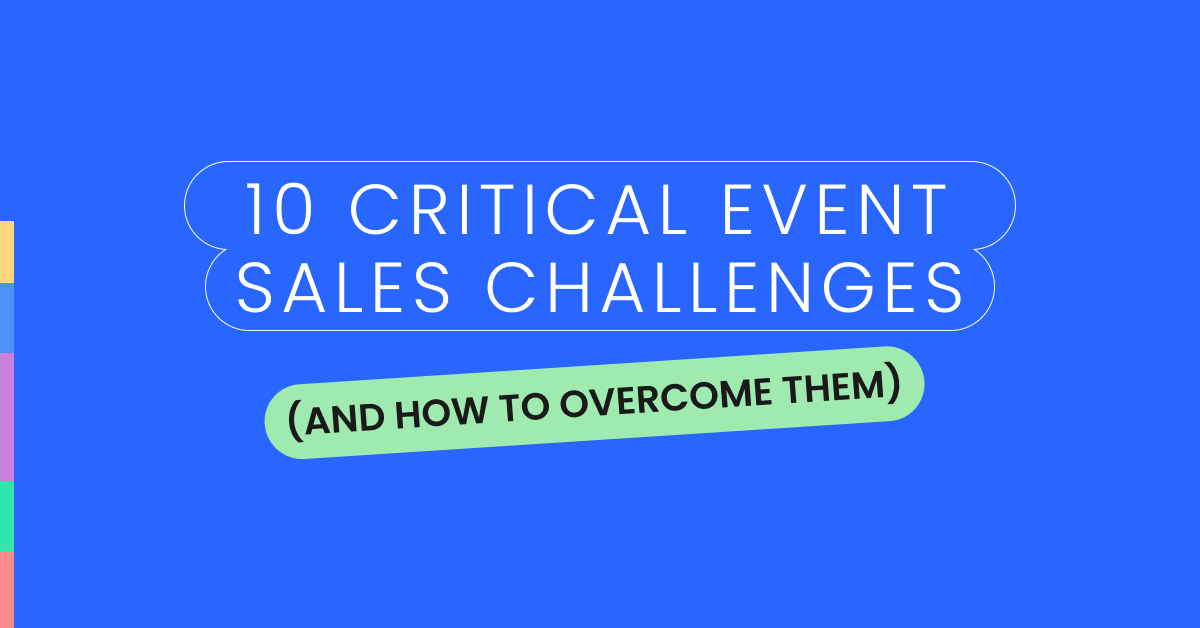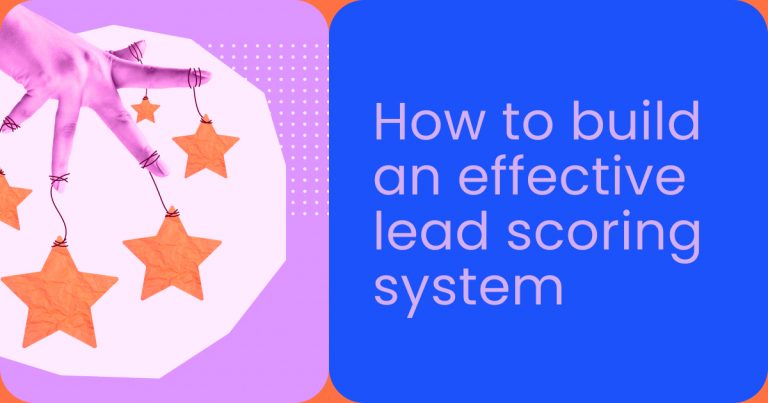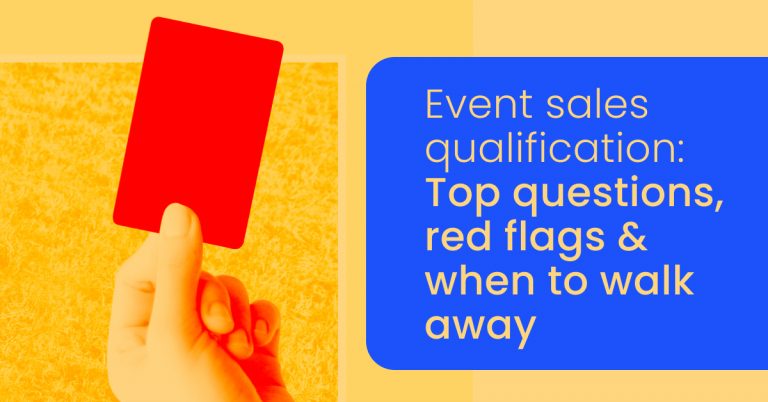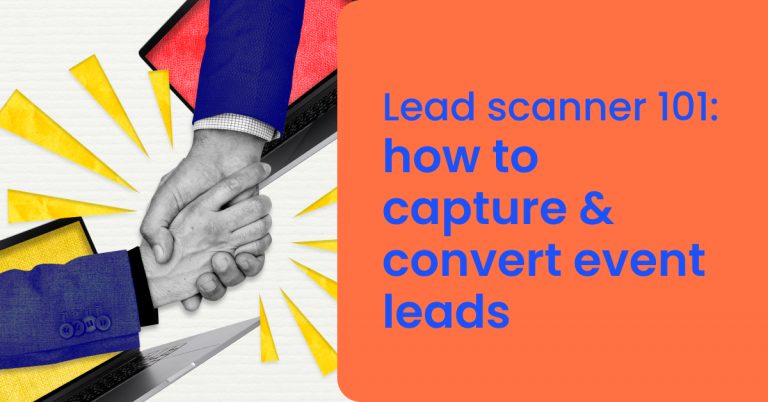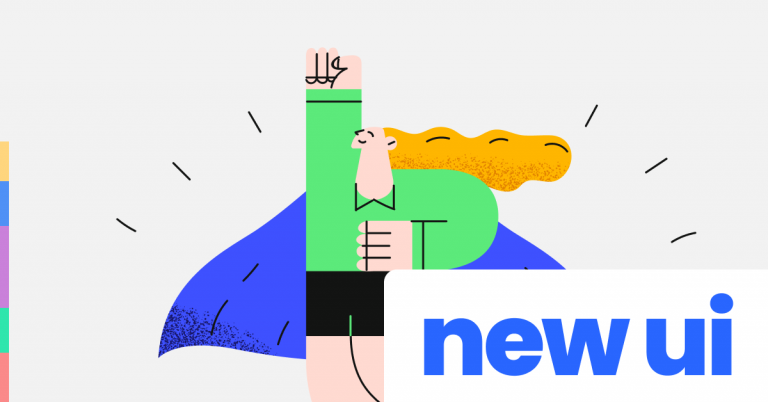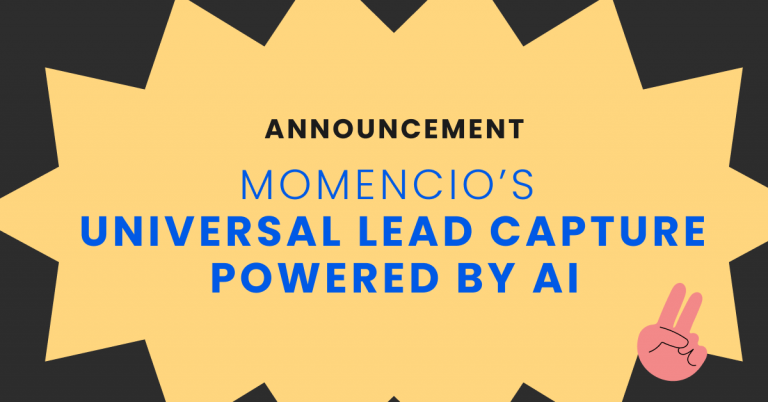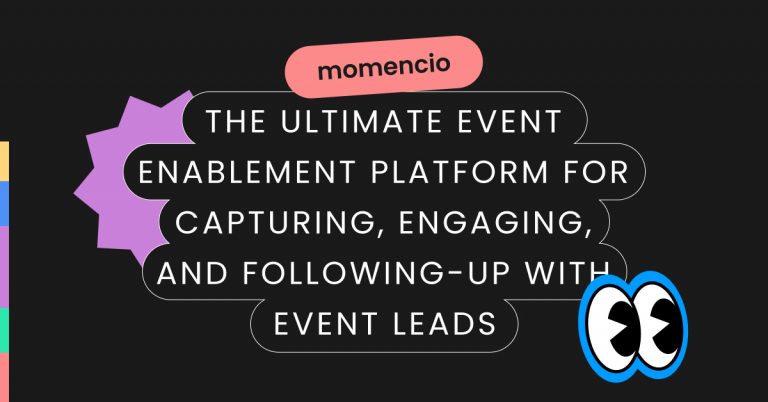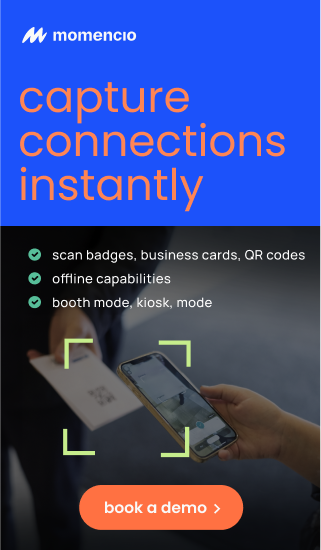Why Event Sales Representatives Struggle to Convert
Events are like the Super Bowl of sales. You’ve got all the right players—potential customers, decision-makers, and influencers—gathered in one place. The excitement is palpable, the energy is high, and the opportunities seem endless. But here’s the kicker: despite all the buzz, the actual conversion of these opportunities into solid leads often feels like trying to catch smoke with your bare hands. Event sales aren’t for the faint of heart—or are they? Let’s find out.
Sales representatives who thrive in the day-to-day grind suddenly find themselves struggling when faced with the chaos of an event. Why is that? Why do events, which should theoretically be a goldmine for lead generation, often result in lackluster outcomes? It’s not due to a lack of skill or effort—far from it. The problem lies in the environment itself and how it drastically shifts the dynamics of the sales process.
In this blog post, we will explore the top 10 sales challenges event sales representatives face and provide actionable strategies to overcome them. Whether you are a seasoned sales professional or new to event sales, these insights will help you enhance your approach and achieve greater success at your next event.
What’s Stopping Sales Representatives at Events?
The challenge is not just in getting attention—it is in holding it, in making an impression that lasts beyond the brief exchange. In an environment buzzing with competition and distractions, how do you make sure your event sales approach stands out?
The Overwhelm Factor
When you’re at an event, everything moves at a breakneck pace. There are people everywhere, all trying to accomplish their own objectives. Attendees are juggling multiple conversations, navigating crowded aisles, and attempting to absorb an overwhelming amount of information—all in a limited time frame. The sensory overload is real, and it affects everyone, including the sales reps.
In this setting, attention spans are incredibly short. Prospects are bombarded with pitches, marketing materials, and flashy displays. In such a high-stakes environment, the usual sales tactics often fall flat. The tried-and-true methods that work in one-on-one meetings or even in cold outreach can suddenly feel inadequate. At an event, you’re not just competing against other businesses; you’re competing against the entire atmosphere.
The Paradox of Abundance
One of the most frustrating aspects for sales reps at events is the paradox of abundance. You’re surrounded by more potential leads than you could ever hope to engage in a regular workday, yet converting even a fraction of them feels nearly impossible. This abundance creates a false sense of security—a belief that the sheer number of opportunities will naturally lead to a higher conversion rate. But in reality, it’s the opposite. The more leads there are, the more difficult it becomes to engage each one meaningfully.
This paradox forces sales representatives into a tough spot: do you try to talk to as many people as possible, hoping that something sticks? Or do you focus on a select few, risking that you might miss out on other valuable opportunities? Neither approach is foolproof, and both carry their own risks. The key challenge here is managing your time and attention effectively—knowing when to go broad and when to go deep.
The Disconnect Between Interest and Action
Another significant challenge at events is the disconnect between interest and action. It’s one thing to capture someone’s interest; it’s an entirely different thing to get them to commit to the next step. At events, people are often interested in what you have to say—after all, they’re there to explore new ideas and solutions. But this interest rarely translates into immediate action.
The reality is that prospects at events are in exploration mode. They’re gathering information, comparing options, and often just browsing. The commitment level is low because they’re not ready to make decisions on the spot. This can be frustrating for sales reps who are used to driving conversations toward a clear, actionable outcome. At events, you need to shift your mindset and expectations. The goal is not necessarily to close deals on the spot but to plant seeds that can be nurtured later.
Navigating the Event Environment
So, what does it take to overcome these challenges? How do you, as a sales representative, navigate the event environment effectively? The answer lies in adapting your strategy to the unique dynamics of events. This means being hyper-aware of the environment, honing your ability to read the room, and developing the agility to shift your approach on the fly.
It’s about understanding that at events, you’re not just selling a product or service—you’re selling your time. You’re selling your ability to listen, to engage genuinely, and to stand out in a crowded space. It’s about creating a connection that goes beyond the transactional, one that will make the prospect remember you long after the event is over.
10 Challenges Event Sales Representatives Struggle With Most
Challenge #1: Capturing High-Quality Leads
One of the most critical aspects of event sales is capturing leads that are not just numerous but also high in quality. In the hustle and bustle of a busy trade show or conference, sales reps often find it challenging to identify and engage with prospects who have genuine potential to convert into customers. This issue is compounded by the sheer volume of attendees, making it difficult to sift through and find those who match your ideal customer profile.
Solution: To overcome this challenge, it’s essential to implement advanced lead capture tools that allow for quick qualification. These tools can include digital badge scanning, mobile apps designed for lead capture, and real-time data analytics that assess attendee engagement levels. By integrating these technologies, sales reps can prioritize leads based on their potential, ensuring that follow-ups are focused on the most promising prospects.
Moreover, leveraging tools that enrich lead data on the spot—such as AI-driven apps that instantly qualify and score leads—can significantly enhance the quality of leads captured. This approach not only saves time but also increases the chances of converting these leads into sales.
Challenge #2: Standing Out Among Competitors
Events are often teeming with competitors, all vying for the attention of the same pool of potential customers. In such a saturated environment, it’s challenging for sales reps to differentiate their offerings and make a lasting impression on attendees. Without a clear strategy to stand out, even the best sales pitches can get lost in the noise.
Solution: The key to standing out at an event is a compelling, unique value proposition (UVP) that clearly communicates what makes your product or service different from the competition. This UVP should be integrated into every aspect of your event presence—from booth design to marketing materials and the sales pitch itself.
Interactive booth elements, such as live product demonstrations, virtual reality experiences, or gamified interactions, can also draw attendees in and keep them engaged. These elements not only capture attention but also provide a memorable experience that sets your brand apart from others. Additionally, using eye-catching visuals and strategic placement of branding materials can further enhance your visibility at crowded events.
Challenge #3: Managing Time Effectively
Time is one of the most valuable resources for sales reps at events, and managing it effectively is often easier said than done. With back-to-back meetings, product demos, and networking opportunities filling the day, it’s easy for time to slip away, leading to missed connections or rushed interactions. Inefficient time management can result in a less productive event experience, reducing the overall impact of your sales efforts.
Solution: Effective time management starts with setting clear goals for the event. Before the event, map out your schedule, prioritizing key activities such as meetings with high-value prospects and essential networking sessions. Tools like scheduling apps can help you organize your day, ensuring that you allocate time for everything, including follow-ups and breaks.
Moreover, it’s important to remain flexible. While having a structured plan is crucial, being able to adapt to unexpected opportunities—such as impromptu meetings or extended conversations with a promising lead—can also significantly enhance your event outcomes. Balancing structure with spontaneity allows sales representatives to maximize their time without missing out on potential sales opportunities.
Challenge #4: Engaging Attendees in Meaningful Conversations
Engaging attendees in meaningful conversations is a significant challenge, especially in a fast-paced event environment. Sales reps often struggle to move beyond surface-level interactions and engage prospects in discussions that uncover their true pain points and needs. Without these deeper conversations, it’s difficult to tailor your pitch effectively and build the trust needed to move a lead further down the sales funnel.
Solution: To foster meaningful conversations, sales reps should prepare a set of open-ended questions designed to encourage deeper dialogue. These questions should be aimed at understanding the prospect’s specific challenges, goals, and motivations. Active listening is also crucial—by paying close attention to what the prospect says, sales representatives can tailor their responses and solutions to address the prospect’s unique needs.
Building rapport quickly is essential. This can be achieved by finding common ground or shared experiences, which helps to create a connection that goes beyond the immediate sales context. Personalized interactions that make the prospect feel understood and valued are more likely to result in meaningful engagements that can lead to sales.
Challenge #5: Dealing with Event Fatigue
Events can be physically and mentally exhausting for both sales reps and attendees. The long hours, continuous social interactions, and the sheer volume of information to process can lead to event fatigue, where energy levels drop, and focus wanes. This fatigue can diminish the effectiveness of sales reps, making it harder to maintain enthusiasm and engagement throughout the event.
Solution: Managing energy levels is key to combating event fatigue. Sales reps should schedule regular breaks throughout the day to rest and recharge. These breaks can be used to hydrate, eat healthily, and practice relaxation techniques such as deep breathing or mindfulness. Taking care of physical well-being will help maintain focus and energy levels, allowing reps to perform at their best even during long events.
In addition to physical breaks, mental breaks are also important. Stepping away from the booth for a few minutes to clear your mind or engaging in a quick, light-hearted conversation with a colleague can help reset your energy and keep you motivated. By managing event fatigue proactively, sales reps can sustain high levels of performance throughout the event.
Challenge #6: Balancing Quantity and Quality of Interactions
Striking the right balance between the quantity and quality of interactions at an event is a delicate task. On the one hand, sales reps want to engage with as many attendees as possible to maximize lead generation. On the other hand, focusing too much on quantity can lead to shallow interactions that fail to establish a meaningful connection with the prospect.
Solution: To balance quantity with quality, sales reps should prioritize their interactions based on the potential of the lead. Use quick qualifying questions to identify high-potential prospects early on and dedicate more time to engaging these leads in deeper conversations. For lower-priority leads, a brief but meaningful interaction that captures essential information for follow-up can be sufficient.
Using a tiered approach to interactions—where top-tier leads receive more personalized attention, while lower-tier leads are noted for future engagement—allows sales representatives to maintain a high volume of interactions without sacrificing the depth of connection with promising prospects.
Challenge #7: Navigating Technology Glitches
In today’s tech-driven events, sales reps rely heavily on technology for lead capture, presentations, and follow-ups. However, technology glitches—such as app crashes, connectivity issues, or data loss—can disrupt these processes, leading to lost data, missed opportunities, and a loss of momentum during critical moments.
Solution: Always have a backup plan in place to deal with potential technology failures. Carry printed materials as a contingency for digital presentations and ensure that essential information is accessible offline in case of connectivity issues. Familiarize yourself with basic troubleshooting techniques for the technology you’re using so that minor issues can be resolved quickly on the spot.
Moreover, performing a technology check before the event starts can help identify and resolve potential issues in advance. This proactive approach minimizes the risk of technology-related disruptions and ensures that sales reps can maintain their focus on engaging with prospects and closing deals.
Challenge #8: Post-Event Follow-Up
After the event, the real work begins—following up with the leads captured during the event to maintain momentum and drive conversions. However, without a structured follow-up strategy, leads can quickly go cold, reducing the chances of a successful sale. The challenge lies in ensuring timely, relevant, and personalized follow-up communication that keeps the lead engaged.
Solution: Developing a structured post-event follow-up plan before the event even begins is crucial. This plan should include personalized follow-up emails that reference specific interactions and interests discussed during the event. Automated tools can be used to schedule and send these follow-ups, ensuring they are timely and relevant.
Segment your leads based on their engagement level and potential value, and prioritize follow-up efforts accordingly. For high-priority leads, consider personalized touches such as a follow-up call or a tailored microsite with content specifically curated for them. A well-executed follow-up strategy can significantly increase the chances of converting event leads into sales.
Challenge #9: Measuring Event ROI
Demonstrating the return on investment (ROI) from event participation is a common challenge for sales reps. Events often involve significant expenses, and without clear metrics to measure the effectiveness of sales efforts, it can be difficult to justify the investment to stakeholders. Sales reps need to quantify the impact of their interactions and show how these efforts contribute to the bottom line.
Solution: To measure event ROI effectively, track key performance indicators (KPIs) such as the number of qualified leads, conversions, and revenue generated from event interactions. Using CRM systems to correlate these activities with sales outcomes can provide a clear picture of the event’s impact.
Additionally, conducting a post-event analysis to assess what worked well and what didn’t can help refine your approach for future events, making it easier to justify the investment and demonstrate value. By systematically measuring event ROI, sales reps can provide concrete evidence of the success and effectiveness of their sales efforts.
Challenge #10: Handling Rejection and Objections
Rejection and objections are inevitable in sales, but they can be particularly challenging in the high-stakes environment of an event. Sales reps must be prepared to handle these situations on the spot, without letting them derail their confidence or momentum. The challenge lies in maintaining a positive attitude and turning objections into opportunities for deeper engagement.
Solution: Anticipating common objections and preparing responses in advance is key to handling rejection effectively. By understanding the typical concerns that prospects may have, sales reps can respond confidently and provide solutions that address these objections.
Moreover, it’s important to focus on the positive aspects of each interaction, even when faced with rejection. Every “no” is an opportunity to learn and improve your approach. By staying resilient and maintaining a positive outlook, sales reps can turn challenging situations into opportunities for growth and ultimately increase their success at events.
Understanding the Event Environment
Cut Through the Clutter
Events, like life itself, are noisy. Not just in the literal sense, but in every possible way. You’ve got hundreds of businesses, dozens of conversations happening all around, and a constant barrage of visuals and sounds designed to grab attention. In this chaotic environment, standing out is more challenging than ever.
The first thing to recognize is that the clutter isn’t just physical—it’s mental. Attendees are processing a lot of information at once, and as a sales rep, you’re just one piece of that puzzle. So how do you ensure that you’re the piece they remember? It’s not about being the loudest or the flashiest. Instead, it’s about being the most relevant and the most genuine.
Quality Over Quantity
It’s tempting to try and talk to as many people as possible. After all, more conversations should lead to more leads, right? But at events, this approach often backfires. When you spread yourself too thin, the quality of each interaction diminishes. You become just another face in the crowd, rather than someone who made a lasting impact.
Instead, focus on quality over quantity. Identify the prospects who are most likely to benefit from what you’re offering and dedicate your time to them. This might mean fewer conversations, but the ones you do have will be more meaningful and memorable. It’s better to have five deep, engaging conversations than twenty shallow ones that go nowhere.
Being Direct and Genuine
In an environment where everyone is trying to sell something, authenticity stands out. Prospects can tell when you’re being genuine versus when you’re just going through the motions. The key is to approach each interaction with a clear, direct purpose but without the pressure of trying to close a deal on the spot.
Start by asking yourself, “What does this person really need, and how can I help them?” Rather than jumping straight into a pitch, take the time to understand their pain points, challenges, and goals. This not only helps you tailor your approach but also builds trust. When a prospect feels that you’re truly interested in helping them rather than just making a sale, they’re more likely to engage with you.
Creative Ways to Stand Out
Standing out in a crowded event doesn’t mean you have to be loud or flashy. Sometimes, the simplest gestures are the most effective. Consider small, creative touches that can make a significant impact. For example, think about how you can enhance an attendee’s experience—maybe by engaging them with personalized multimedia content based on the need of the hour that feels tailored just for them. Advanced event engagement tools quietly power these creative interactions, making the connection seamless and natural.
Imagine giving them access to a customized microsite featuring curated content specifically tailored to their needs—something they can refer back to long after the event is over.
Another strategy is to make your booth or presentation interactive. People are more likely to remember experiences than just conversations. By sharing digital collaterals right at the booth, you can ensure that your interaction is not only memorable but also immediately actionable.
The Power of Storytelling
One of the most powerful tools in cutting through the clutter is storytelling. Humans are wired to remember stories, and at an event where everyone is throwing facts and figures, a well-told story can be a breath of fresh air. When you share a story that resonates with your prospect’s situation, you’re not just selling a product—you’re connecting on a personal level.
Think about the stories that highlight the impact of your product or service. How has it helped others? What challenges did it solve? When you frame your pitch within the context of a story, it becomes more relatable and memorable. Plus, it allows you to convey your message in a way that’s engaging rather than overwhelming.
The reality of events is that they’re cluttered and chaotic, but that doesn’t mean you have to be. By focusing on quality interactions, being genuine, using creative touches, and leveraging the power of storytelling, you can cut through the noise and make a lasting impact. The key is to remember that in a sea of distractions, it’s not about being the loudest voice—it’s about being the voice that resonates.
Master the First 30 Seconds
In the whirlwind environment of an event, first impressions are everything. The initial 30 seconds of an interaction can determine whether a conversation will lead to a potential lead or fizzle into another forgettable encounter. It’s a small window of time, but it carries significant weight. As a sales representative at an event, your challenge is to make those 30 seconds count.
Why the First 30 Seconds Matter
At events, attendees are bombarded with information from all sides. They’re moving quickly from booth to booth, filtering through the noise to find what’s relevant to them. In this context, your first few moments with a prospect are crucial. They’re assessing you just as much as you’re assessing them, and if you don’t capture their interest immediately, you risk losing them altogether.
The first 30 seconds set the tone for the entire interaction. It’s your opportunity to establish rapport, convey your value proposition, and differentiate yourself from the competition—all before the prospect decides whether to continue the conversation or move on. That’s a lot to accomplish in a short time, but with the right approach, it’s entirely possible.
Starting Strong: The Power of a Hook
Just like a strong opening line in a story, your first words to a prospect need to grab attention. A generic greeting or a rehearsed pitch isn’t going to cut it. Instead, think about what will genuinely pique their curiosity and make them want to know more.
One effective strategy is to lead with a question or a statement that directly addresses a common pain point or challenge in your industry. For example, if you know that your target audience struggles with a specific issue, bring it up right away: “Are you finding it difficult to manage leads effectively after events?” This not only engages them but also shows that you understand their world.
Another approach is to offer an unexpected insight or piece of information that challenges conventional thinking. People are naturally drawn to ideas that make them think differently. If you can surprise them with something they haven’t considered before, you’re more likely to hold their attention.
The Importance of Body Language
Your words matter, but so does your body language. In fact, studies have shown that nonverbal communication can be even more influential than what you say. In the first 30 seconds, your posture, eye contact, and gestures can either reinforce your message or undermine it.
Start by maintaining open and confident body language. Stand tall, face the prospect directly, and make consistent eye contact. This conveys confidence and approachability, making it easier for the prospect to engage with you. A warm, genuine smile can also go a long way in making the other person feel at ease.
Be mindful of your gestures as well. Avoid crossing your arms or fidgeting, as these can signal discomfort or disinterest. Instead, use your hands to emphasize key points or to invite the prospect into the conversation. Subtle, intentional gestures can help build rapport and make your interaction more dynamic.
Listening Before Speaking
In the rush to deliver your pitch, it’s easy to fall into the trap of talking too much, too soon. But remember, the best conversations are two-way streets. Before diving into your product or service, take a moment to listen to the prospect. Ask an open-ended question that encourages them to share their thoughts, challenges, or goals.
For example, instead of launching into a pitch about your latest software, you might start with, “What are you hoping to get out of this event?” or “What’s the biggest challenge you’re facing with your current solution?” This not only gives you valuable insight into their needs but also shows that you’re interested in their perspective.
Active listening—really paying attention to what the other person is saying—can help you tailor your message on the fly. By responding to their specific concerns, you make the conversation more relevant and engaging. This approach also helps build trust, as the prospect sees that you’re not just trying to sell to them—you’re genuinely interested in helping them.
Crafting a Memorable Value Proposition
Once you’ve engaged the prospect and understood their initial thoughts and requirements, it’s time to present your value proposition— but do it in a way that resonates with their challenges and expectations that you might have learned during your earlier interaction. Instead of a one-size-fits-all pitch, you can craft unique event games and interactive experiences to match the diverse preferences and interests of your prospects and connect your offering directly to their specific needs.
Keep your value proposition concise and to the point. You don’t need to go into every detail of your product—just enough to spark their interest and make them want to learn more. The goal in these first 30 seconds is to create a hook that will draw them into a deeper conversation.
Ending on a High Note
As you wrap up those crucial first 30 seconds, make sure you leave the prospect with a clear next step. Whether it’s inviting them to a demo, setting up a follow-up meeting, or simply exchanging contact information, give them a reason to continue the conversation.
But don’t force it. If they’re not ready to commit to anything specific, that’s okay. The important thing is to leave them with a positive impression and the feeling that you’re someone worth talking to again. A simple, “I’d love to chat more if you have time later,” can keep the door open without being pushy.
Mastering the first 30 seconds of an interaction at an event is about more than just saying the right words. It’s about making a connection, showing genuine interest, and setting the stage for a meaningful conversation. When you approach these moments with intention and focus, you lay a strong foundation for building a relationship that can lead to a valuable lead—and ultimately, a successful sale.
Leverage Technology and Strategy
Technology and strategy are your secret weapons at events. When used effectively, they can help you turn brief interactions into solid leads. But the key is not just to have the right tools or a well-laid plan—it’s knowing how to apply them in a way that enhances, rather than replaces, the personal connection.
Using Tech Wisely
Let’s get one thing straight: tech should support your sales process, not overwhelm it. At events, you don’t need to show off all the bells and whistles. Instead, focus on how technology can streamline your work and make every interaction count.
Start with the basics—capture information on the spot. Scan QR badges or business cards, add notes to enrich your prospect profile, and update contact details. The idea is not to be flashy; it’s about being efficient. When you follow up, you’ll have all the details you need, neatly organized and ready to go.
Not all leads are created equal, and you don’t want to waste time on those that aren’t likely to convert. Some advanced lead retrieval tools empower you to build a rich digital library and monitor your prospect’s engagement efforts in real time. All top-tier solutions offer lead scoring mechanism that analyzes data from your prospects’ interactions to tell you who’s hot and who’s not. Focus on the leads that show the most potential, and let the others cool off for a while.
Following Up Without Being Pushy
The follow-up is where the real magic happens. But let’s face it: no one likes to be hounded. The trick is to stay top-of-mind without being a pest.
Timing is everything. Don’t wait too long to reach out—strike while the iron is hot. But don’t send out a generic email blast either. Make it personal. Reference something specific you discussed at the event. It shows you were paying attention, and it sets you apart from the crowd.
For example, instead of saying, “Thanks for stopping by our booth,” try, “I enjoyed our conversation about how you’re handling lead management after events. Here’s a case study I think you’ll find relevant.” This approach not only reminds them of your conversation but also adds value, making them more likely to stay engaged.
And here’s a pro tip: offer something actionable. It could be a demo, a free trial, or a consultation. You’re not pushing for a sale—you’re inviting them to continue the conversation. It feels natural, not forced, and it gives them a reason to keep talking to you.
But what if they’re not ready to move forward? That’s okay. Respect their timeline but keep the lines of communication open. Send them occasional updates or share relevant content. It’s about staying on their radar without overwhelming them. Patience and consistency build trust, and trust is what turns leads into long-term relationships.
Conclusion
Navigating the complexities of event sales requires a strategic approach and the ability to overcome a range of challenges. From capturing high-quality leads to managing post-event follow-ups, each challenge presents an opportunity to refine your sales strategy and achieve better results. By understanding these common obstacles and implementing the solutions outlined above, sales reps can maximize their effectiveness and drive significant business growth through event participation.
FAQs – Event Sales
- What are the biggest challenges that event sales representatives face?
- The most pressing challenges for event sales representatives include capturing high-quality leads, standing out among competitors, managing time effectively, and handling objections.
- How can sales representatives manage time effectively at events?
- Sales representatives can manage time effectively by setting clear goals, prioritizing key activities, using scheduling tools, and remaining flexible to adapt to unexpected opportunities.
- What is the best way to follow up with leads after an event?
- The best way to follow up is to have a structured plan in place, use automated tools for timely communication, and personalize follow-ups based on specific interactions during the event.
- How can sales representatives stand out among competitors at events?
- Sales representatives can stand out by developing a compelling, unique value proposition (UVP), using interactive booth designs, and engaging prospects with memorable experiences.
- Why is it important to measure event ROI?
- Measuring event ROI is important to justify the investment, demonstrate the effectiveness of sales efforts, and refine strategies for future events based on concrete data.
Interesting Facts from Research
- Event Leads Need Speed: 83.9% of event marketers say lead gen is their #1 goal. That means if you’re not following up on those leads immediately, you’re leaving money on the table.
- Standing Out is Everything: 80% of event organizers swear by in-person events as their top marketing channel. If you are not optimizing your booth for conversion, you’re wasting a golden opportunity.
- Booth or Bust: 82% of attendees have buying authority. If your booth isn’t grabbing attention, you’re missing out on serious decision-makers.
